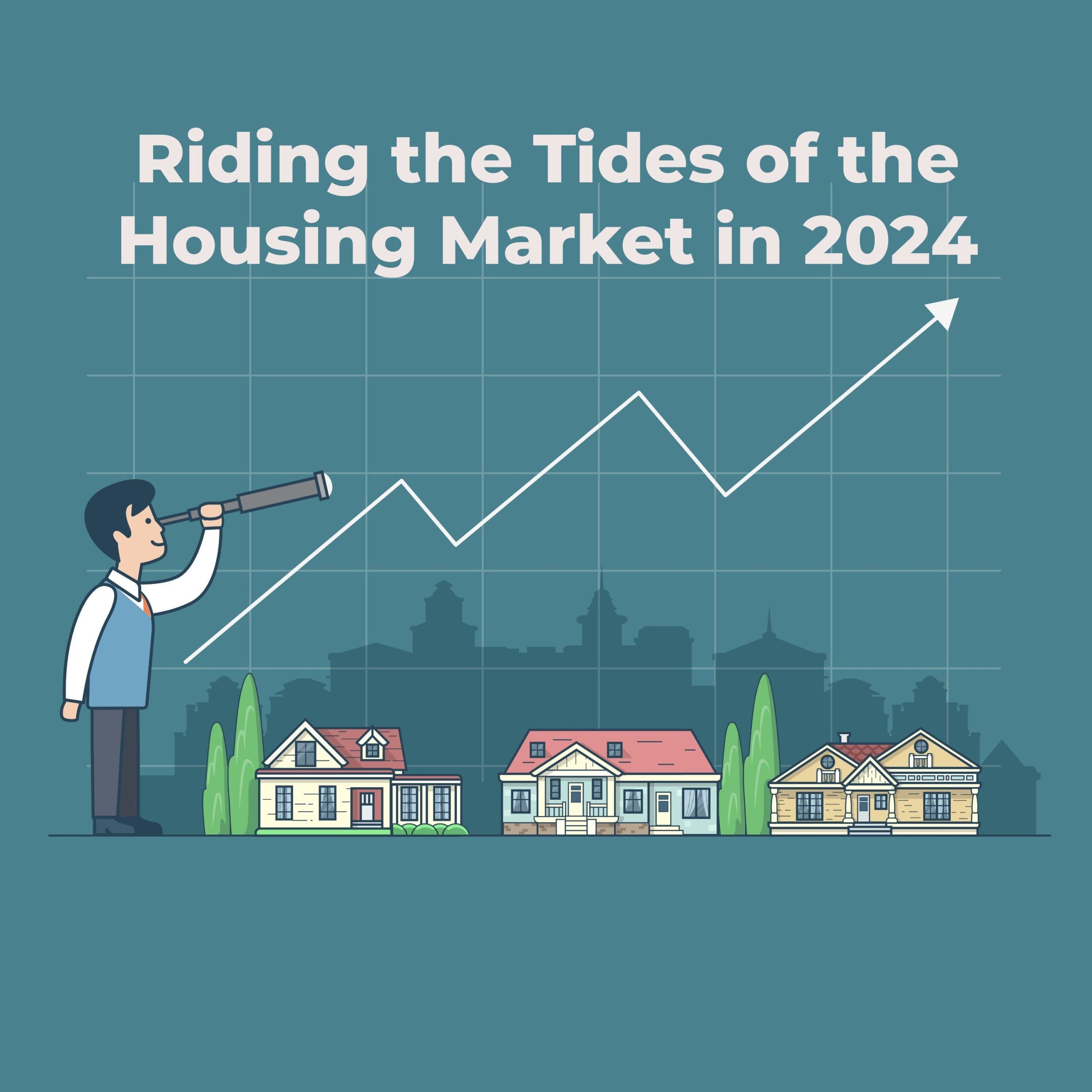Riding the tides of the Housing Market in 2024. Picture this: after cresting the peak in the preceding years, the market surged downhill dramatically, with sales of pre-existing homes recording a precipitous drop of 19% year-over-year. Consequently, this market chill is reflected in the median home price. Which ascended to a notch of $387,600 in November 2023, a 4% rise from the preceding year, despite the stinging winds of turbulence. Furthermore, mortgage rates echoed the gale of instability, dipping and rising unpredictably. Culminating in an average of 6.9% in the fateful year of 2023, following a spike beyond the 7% marker in late 2022.
Dawn has risen upon a new year, and as we traverse the uncertain lanes of 2024. We anticipate a scenic ensemble of continuity and change laid on the housing market’s horizon. With dropping inflationary clouds, experts predict a gentle dwindling in mortgage rates to a comforting 6.5–6.8% annual average. While this shift might inject a modest pulse into home sales. A prevailing scarcity of inventory may shackle any significant growth potential. Additionally, the wind is expected to blow towards the south, causing home prices to slip marginally by 1–2%. Riding the tides of the Housing Market in 2024.
Charting the Course: Housing Market Predictions for 2024
Predicting Mortgage Rates
As we cast our gaze upon the crystal ball of predictions. It reflects an average mortgage rate of 6.5–6.8% for the 30-year fixed slot across 2024, a soothing lull from the 6.9% average that marked 2023. Our fortune-tellers attribute this retreat to a receding tide of inflation. Granting the Federal Reserve an opportunity to cease hiking interest rates. Even so, the chances of rates plunging below the 6% rampart seem slim, unless an economic downturn breaches the gates. Consequently, while these slight nose-dives in rates might nudge affordability up a notch, the remaining high expenditure echoes from pre-2020 times.
Home Prices
Navigating through turbulence, the median sale price for existing homes hit a record-breaking $413,800 in June 2022. Before a slight dip and a subsequent rebound, finally settling at an annual increase of 4% in 2023 at $387,600. To chart the course for 2024, forecasts suggest a gentle dip of 1–2% in national median prices. Nestling between approximately $375,000 and $385,000. The slight breeze of affordability augmented by lower rates and a marginal increase in supply to satiate the buying appetite might exert a downward push on prices. Yet, persistent underbuilding coupled with a squeeze on inventory may serve as a bulwark against drastic decreases. Regional disparities are expected, especially within areas experiencing a pandemic-era real estate boom, where the possibility of larger slides looms.
Existing Home Sales
Having peaked in 2020–2021, the sales of pre-owned homes embarked on a plunge as affordability tightened its grip in 2022. And shrank even further in 2023, registering a 19% decrease year-over-year. With an annual volume of 3.95 million units in December 2023. A marked contrast from the 4.88 million witnessed in the corresponding period of 2022. Forecasts for 2024 oscillate between a steady-state and a marginal rise of up to 5%. However, chronic scarcity in home availability may curtail the surge in sales. Restricting potential recovery from 2023’s projected 4.07 million total to the early 4 million ballpark, marginally surpassing 2021 levels.
Housing Inventory
Throughout 2021–2023, the housing market grappled with the stranglehold of tight inventory. The supply invariably lagging by a significant half below the 5-month norm necessary for a balanced market. In December 2023, existing homes available for sale barely scraped above a million. (1.03 precisely) A meager supply for 4.4 months, slipping further by 6% from 2022. For 2024, despite the constricted relief anticipated as better buyer affordability stimulates owners to sell. Year-end inventory is likely to trail 2023’s total by up to 14%. With the gap between new construction and household formation persistently gaping wide, it leaves buyers with limited choices.
Market Dynamics: Buyers vs Sellers
The persistent chasm between buyer demand and homes available for sale, particularly within the mid-to-lower price range. Tips the scales in favor of sellers and begs no shift in the baseline marketplace dynamics for 2024. Buyers must steel themselves to make compromises on closing costs. Inspection contingencies, and other buyer-friendly terms to emerge victoriously from the increasingly fierce bidding wars. However, a significant outperformance in mortgage rates or inventory conditions against current forecasts. May lead to a slight tipping of the scale, giving buyers a little more leverage.
Wildcard Factors
Just as in a thrilling rollercoaster ride, unexpected twists and turns are part of the game. Major fluctuations either in the global economic sphere or unforeseen events could deviate the 2024 housing market’s trajectory with potential impacts upon prices and sales. These turning tides could emerge from a variety of channels. From swift reductions in inflation and faster decreases in rates to heightened energy costs due to international conflicts, and even the impact of election cycles.
Essential Takeaways for Residential Real Estate Appraisers
As a residential real estate appraiser bracing yourself for the year 2024, here are some key points and recommendations to consider:
- Stay vigilant of the projected modest drop in home prices and adjust accordingly.
- Keep an observant eye on the growing housing supply, understanding its implications on property values.
- Monitor trends in mortgage rates and affordability issues and note their implications on the dynamics of the market.
- Stay informed about rental market trends, particularly the demand landscape for variable types of rental units.
- Understand the nuances of regional market variations and the contributing factors, such as climate risk and ‘boomerang migration,’ and their potential impact on property values.
- Keep abreast of updates in real estate transaction processes and emerging technology integrations.
- Complete the 2024-2025 7 hour National USPAP Update course sooner than later to be a breast to the number of changes.
- Stay current with political and economic elements capable of influencing the housing market.
In Conclusion
Although the 2024 housing market forecasts hint at possible slight relief from the frenzied highs. Substantial strides towards a more buyer-friendly environment seem elusive sans unpredictable market volatility. However, the double-edged sword of descending home prices and mortgage rates. Along with a gradual surge in inventory, may breathe life into sluggish sales activity. Nevertheless, chronic inadequacy of affordable homes to fulfill buyer demand. Coupled with costs surpassing historical standards, resoundingly dominates the narrative, hindering the market’s potential for equilibrium. As we continue riding the tides of the housing market in 2024.
Related Blog Posts
Join Over 100,000 Students Enjoying Manfred School Now
Become Part of Manfred School to Further Your Career.





